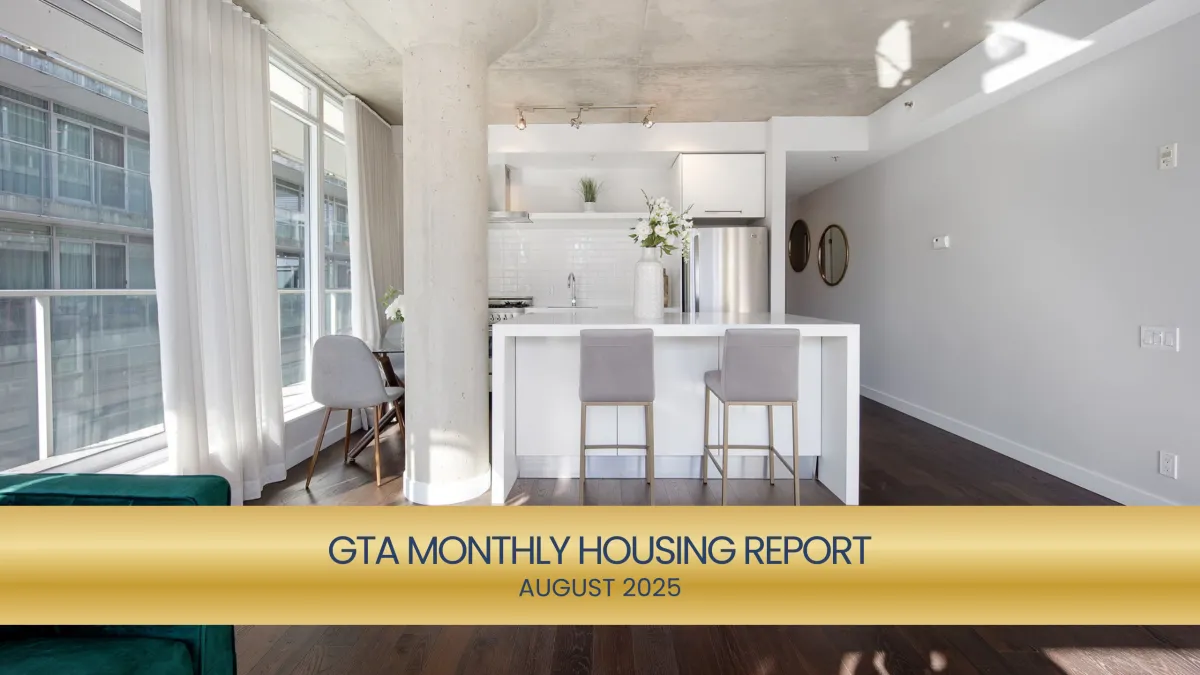
August 2025 GTA Monthly Housing Report
Sales Momentum Continues to Grow
Demand improved for the fourth month in a row, with momentum picking up in July as buyer confidence continued to make its way back into the market. Buyers are becoming more accustomed to the economic uncertainty stemming from the trade conflict with the U.S., while realizing that interest rates are likely close to their bottom. With a record amount of supply on the market, negotiation power is being leveraged to strike deals.
Sales Increase to Four-Year High: Total MLS sales increased on a year-over-year basis for the first time in eight months during July, rising 11% to a four-year high of 6,100 transactions. On a seasonally adjusted basis, sales rose 13% from June, marking the fourth consecutive month-over-month increase. However, year-to-date sales were down 14% from 2024, with July activity falling 21% below the 10-year average. The latest 12-month rolling total of 62,856 sales remained well below the long-run average of approximately 90,000 sales.
Growth in New Listings Slows: Demand increased at a faster pace than supply for the first time this year, with new listings rising 6% annually to 17,613 homes. While the number of active listings at month-end has levelled out over the past couple months, it was 26% higher than a year ago and remained at a record high of 30,215 units in July — 75% above the 10-year average.
Market Conditions Tighten but Remain Unbalanced: Market conditions tightened slightly in July as the ratio of sales-to-new listings rose to 35%, its highest point of the year and above the 33% level from a year ago. However, the ratio still signalled a buyer’s market (a balanced level is 45-60%). Furthermore, inventory on the market was equal to 5.0 months of supply, which was up from 4.4 months last year and double the 10-year average of 2.5 months.
Prices Down 5.5% Annually in July: Average MLS prices decreased 5.5% annually in July to $1,051,719, the largest year-over-year decline recorded since April 2023. On a seasonally adjusted basis, MLS prices edged up 0.3% from June. Overall, average MLS prices have seen little change over the past four years, down by only 1.1% compared to July 2021, while still remaining 12.5% higher than the level from five years earlier. Compared to the market peak in February 2022, prices were down 21.2%. Over the last 10 years, prices grew by an average of 5.9% annually.
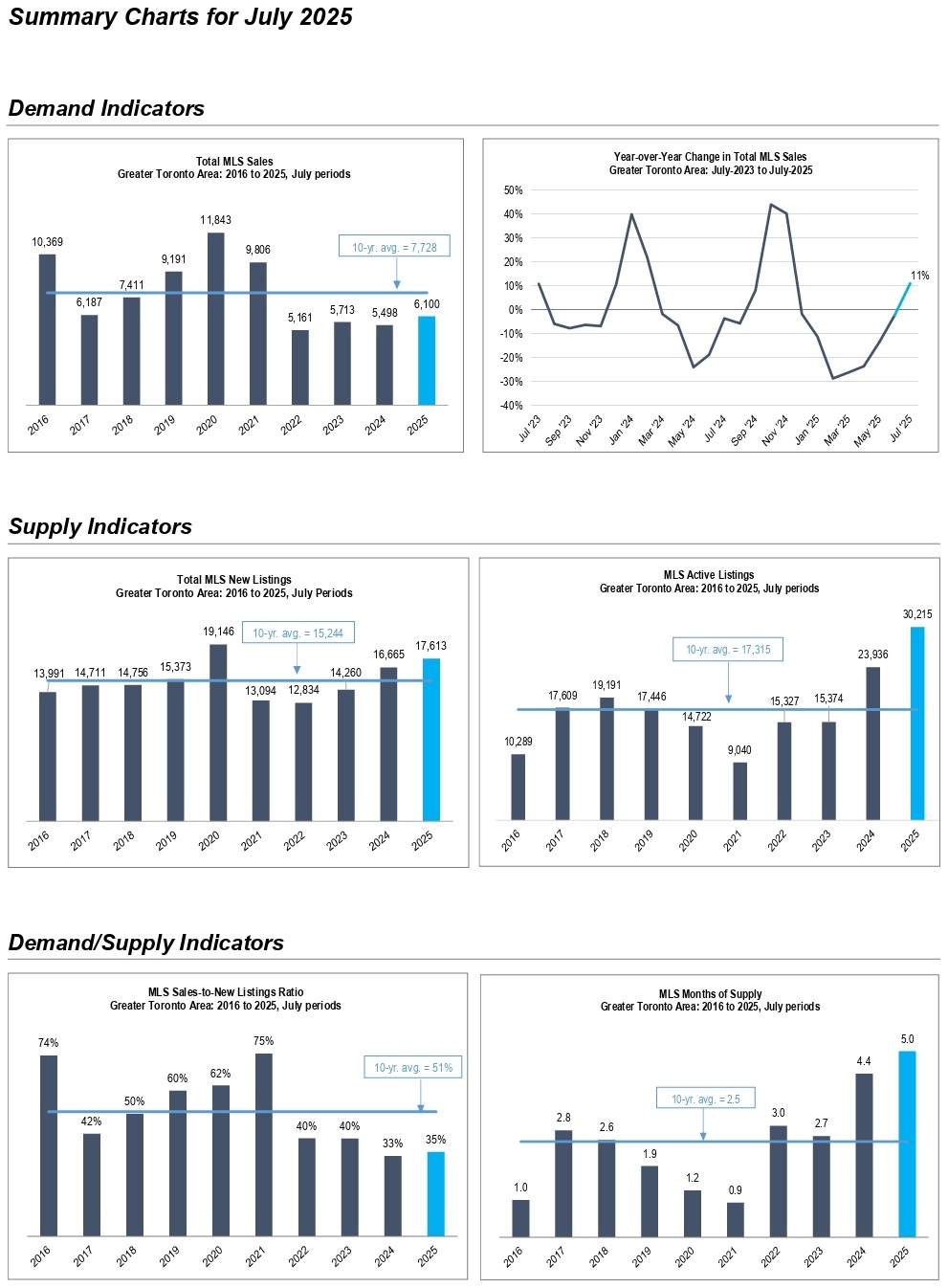
Semis/Rows/Towns Lead Sales Growth: Sales increased the most compared to a year ago for semis/rows/towns (+14%) and detached homes (+11%). While condo sales also experienced year-over-year growth, the 6% increase was smaller than other housing types. Condo sales in July were 24% below their 10-year average, while detached and semi/row/town sales were 21% and 18% below their 10-year averages, respectively.
Growth in Condo Supply Slowing: New condo listings fell 5% from a year ago in July, helping to slow the accumulation of inventory on the market. Active condo listings remained at a record high in July at 10,013 units, but the annual pace of increase moderated to 13% — its slowest annual growth rate in two years. Compared to condos, annual growth in active listings was notably stronger for detached homes (+34%) and semis/rows/towns (+31%).
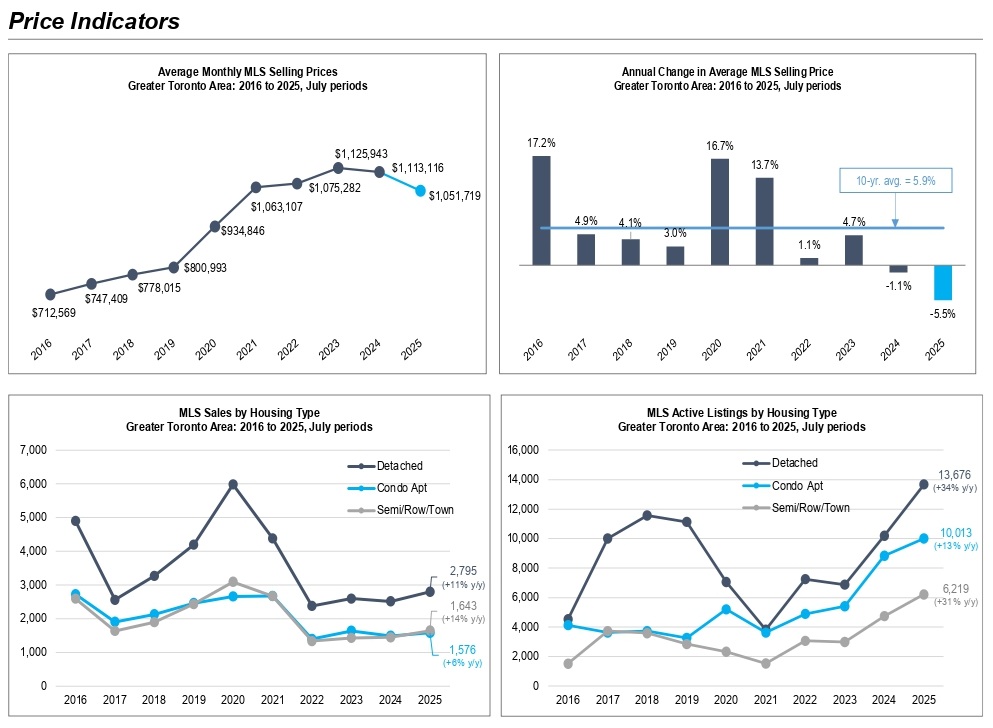
Inventory Growth Shifting from Condos to Low-Rise Homes: Months of supply for condos decreased to a four-month low of 6.4 months, down from the recent high of 7.1 months in May 2025. However, supply levels for condos still remain higher than a year ago and more than double the 10-year average of 2.9 months. In contrast, detached and semi/row/town homes have seen their months of supply climb to 30-year highs, reaching 4.9 and 3.8 months, respectively.
Condo Prices Drop 9% from Last Year: Despite showing some signs of inventory stabilizing, average condo prices dropped 9.3% year-over-year in July to $651,483 — the lowest level since February 2021. Average prices for detached homes fell 5.1% annually to $1,361,660, the lowest level since January 2024, while prices for semis/rows/towns declined 4.9% from a year ago to an average of $919,021, the lowest level since December 2022. Compared to five years ago in July 2020, average prices were up 19% for detached homes and up 15% for semis/rows/towns, while condo prices increased only 3%.
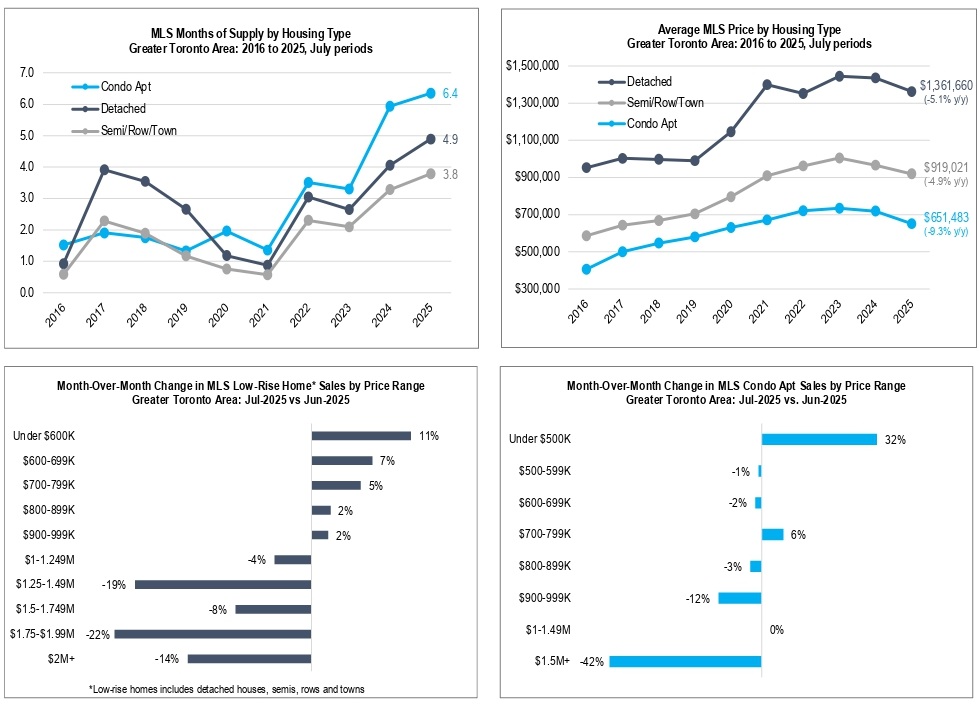
Monthly Sales Growth Focused on Lowest Priced Properties: Sales continued to rise on a month-to-month basis for the least expensive homes, with low-rise homes seeing growth across all price segments below $1M and condo sales rising 32% for units under $500K. Meanwhile, the higher-end of the market was impacted by a seasonal slowdown between June and July, with low-rise home sales down the most within the $1.75-1.99M bracket (-22%) and condos sales above $1.5M falling 42% month-over-month.
Large Shift to Lower-Priced Homes Weighs Down Average Prices: Part of the downward pressure on average selling prices over the past year is attributed to a large shift in sales activity towards the least expensive properties. Low-rise home sales under $700K increased by more than 60% compared to a year ago, while condo sales under $500K increased 125%.
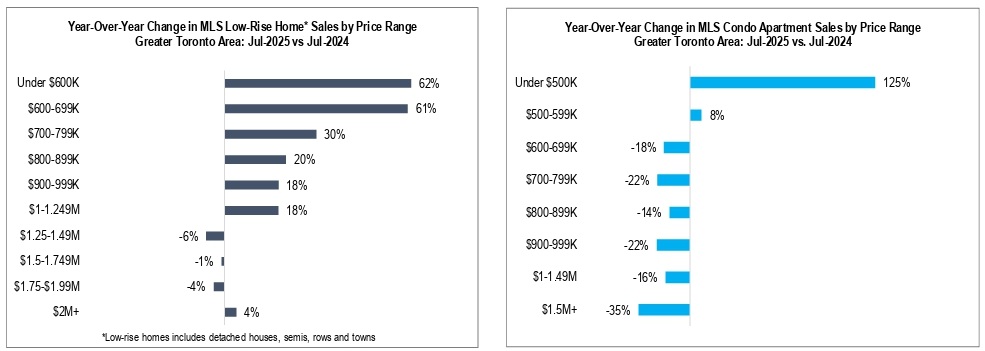
Market Strongest for Semis/Rows/Towns in Toronto: The strongest segment of the GTA housing market in July was semis/rows/towns in the City of Toronto, which recorded annual sales growth of 29% and only a 1% annual decrease in average prices. Semis/rows/towns in Toronto had the lowest amount of inventory in the market at 3.3 months, with only 2.8 months in Toronto East.
Detached Inventory Lower in Toronto than 905: Sales for detached homes grew at a similar annual rate in the City of Toronto (+13%) and the 905 Region (+12%) in July, with average prices down by similar amounts of 5% (City of Toronto) and 6% (905 Region). However, inventory for detached homes was notably lower in Toronto (4.1 months) than in the 905 Region (5.0 months).
Peel Region with Highest Condo Inventory: The 905 Region recorded 10% annual growth in condo sales in July, compared with 3% annual growth in Toronto. Annual declines for average condo prices were similar in Toronto (-9%) and the 905 Region (-10%), with similar amounts of inventory at 6.3 months (Toronto) and 6.4 months (905 Region). Condos in Peel Region had the highest inventory in the GTA housing market at 6.9 months.

Key Takeaways
The slow and steady improvement in demand between April and June gained speed during July. While activity still remains well below normal, a return to positive annual sales growth provided confirmation that an upward trend has been established and the recovery is back on track. According to CREA, the GTA has been leading the sales recovery across Canada, with home sales rebounding by a cumulative 35.5% since March.
This is a very positive sign given that activity usually quiets down during the summer months and that there has been very little, if any, clarity regarding the economic outlook and the potential impacts of the trade dispute with the U.S. Pent-up demand can’t be held back indefinitely, and buyers waiting on the sidelines are now looking to take advantage of price discounts and ample selection in the market.
As widely expected, the Bank of Canada held its benchmark policy rate at 2.75% for the third consecutive time on July 30, noting the resiliency of the Canadian economy (unemployment held steady at 6.9% in July) and inflation remaining firmly within its 2% target range (1.9% in June). According to discussions among the governing council, there is a view that further interest rate cuts may be needed if the labour market softens further. Comments from the Bank of Canada and forecasts from economists suggest that rates are close to their projected lower bound.
With the realization that interest rates are unlikely to see any major downward shifts, and that mortgage rates in the low-4% range are considerably lower than the past few years, buyers have become more comfortable taking action. The 5.5% decline in average prices from a year ago has improved affordability and acted as a market stimulant in the same way as interest rate reductions.
Even with demand improving, prices may continue to see some further modest declines in the coming months as the record amount of inventory on the market continues to grow during the fall. However, any significant drops are unlikely given the resiliency for prices displayed in recent years. In that sense, the next few months may represent an ideal buying opportunity.
While the condo market is at greatest risk of further price declines, the 9% annual price drop in July may start to move more demand into the market. The surge in sales activity for the least expensive units indicates that buyers are still active at certain price points. Furthermore, the fact that there are numerous groups actively looking to purchase blocks of units from developers shows that strategic buyers are sensing a market close to its bottom.
The semi/row/town market in the City of Toronto, which is considered a bellwether for the GTA market as a whole, is showing renewed strength and tightening conditions that could spill over into other segments in the coming months.
